|

On eBay Now...
WWII M26 Life Preserver Belt, in Box (c. 1943 \"General Tire & Rubber Co.\") NOS For Sale
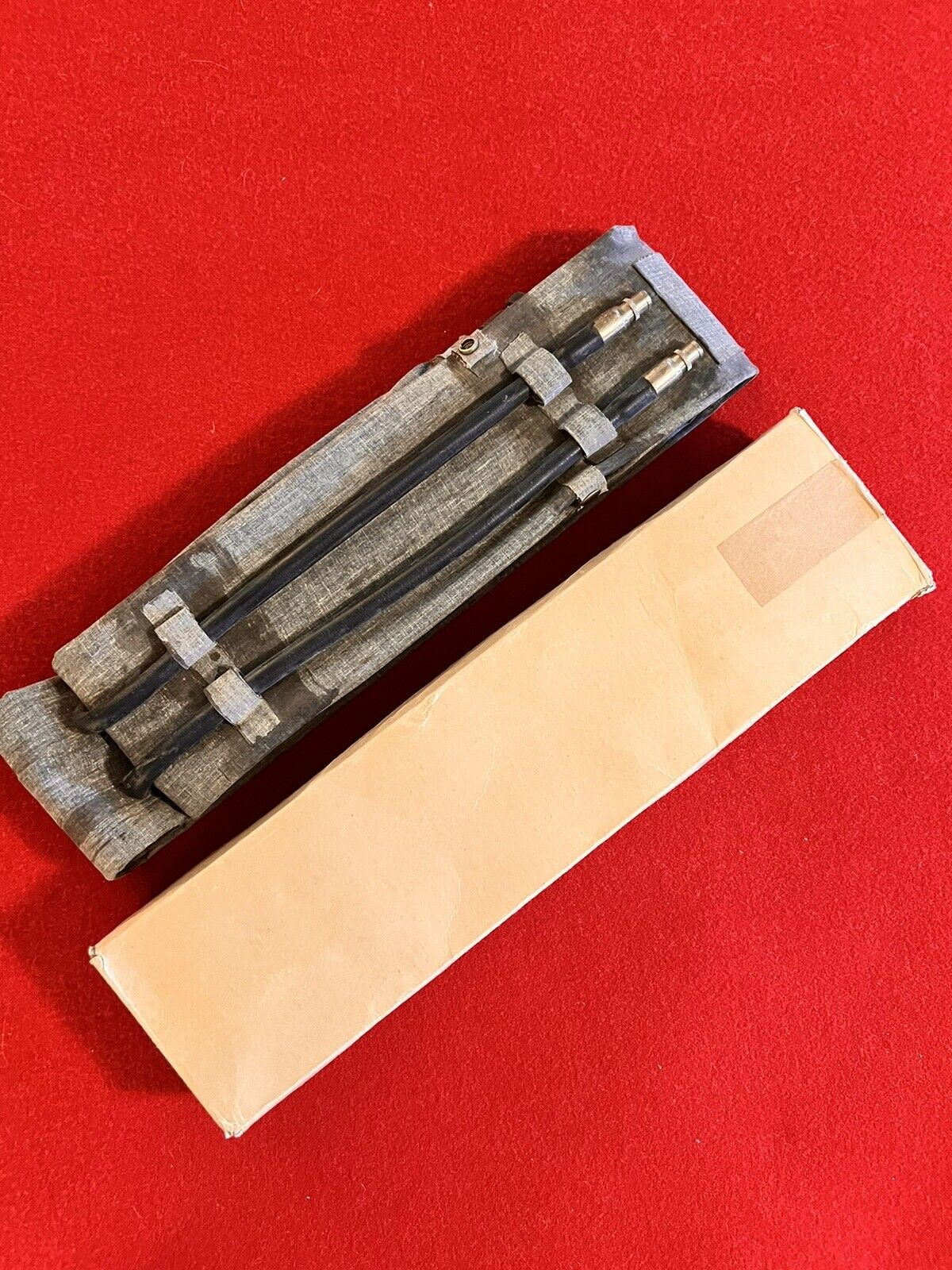
When you click on links to various merchants on this site and make a purchase, this can result in this site earning a commission. Affiliate programs and affiliations include, but are not limited to, the eBay Partner Network.

WWII M26 Life Preserver Belt, in Box (c. 1943 \"General Tire & Rubber Co.\") NOS:
$295.00
WWII \"DUAL TUBE\"Life Preserver Belt (M26 USN USMC Army)thisis a scarce Army contract belt (\"Contract No. W-33-034-TC-25\"), not Navy, circa 1943!! This Army Contract Belt was made by the GENERAL TIRE & RUBBER CO. of Akron, Ohio, and the CO2 assembly was provided by SPARKLETS, and comes in its original pasteboardShippingCarton!! D-Day;Normandy Invasion; USMC (Tarawa, Eniwetok, Iwo Jima); USN (Carriers,Destroyers and all \"ships of war\") USMC and ARMY river crossings in both the Pacific and the European Theaters of Operations. See the photos of (1) the Marine of the 27th Regiment, 2nd Battalion on Iwo Jima, 1945 wearing this belt, and (2) the soldiers on Normandy, June 1944 coming ashore, drenched but alive, wearing these belts.
MintNOS Unissued! Thisis a stunning, untouched example in museum-grade condition in its original carton!!! Thisone is a beauty!!! Some of these Dual Tube Belts were manufactured in Tan rubberized fabric, and some in Gray rubberized fabric. This is one of the latter.
+If actually issued this example could very well have gone ashoreonIwoJimainFebruary 1945. (See the included photo of the Eastern Beach ofIwoJima!! +Often referred to by collectors as an\"InvasionBelt\"oras the\"M26Life Preserver\"andassociated with the Normandy invasion of 6 June 1944, it was worn byboth Marines and Army personnel during amphibious landings prior toand following D-Day... as well as aboard ship by Navy personnel andtroops when on deck. This was an innovation of the Second World War,designed by Edward Craig and Lloyd Straits in1942toreplace bulky Kapok-filledand cork-filled \'vest\' and \'belt\'preservers. +Not only were these worn about the waists of Marines, sailors, andsoldiers, but these\"DUALTUBE LIFE PRESERVERS\" were lashed to all manner of heavy signaland medical equipment and weapons to assist in lugging them ashorethrough the surf +The sands as well the black basaltic beach ofIwoJima(February1945) were littered with these\"DUALTUBE LIFE PRESERVERS\"wornashore by Marines of the5th,4th, and 3d MAR DIVsoftheVAMPHIBIOUS CORPS. +TheseDualTube Pneumatic Life Preserver Beltsweremade under bothARMYContracts(theArmyCont. No.\'sprefacedwith the letter\'W\')and theU.S.NAVYContracts(theUSNCont. No.\'sprefacedwith the letters,\'NS\').It is believed that both Army and USN contract belts were worn byMarines, soldiers, and sailors These were both carried byQuartermasters as troops were boarding as well as being issued from\"ship\'s stores\" on troop ships carrying the invasiontroops. This example is marked clearly with the Army number both on the carton and the belt itself: Contract No. W-33-034-TC-25
+As mentioned above these belts are widely known asM26(or M1926) Life Preservers,but there is no documentary evidence that would suggest that thisinnovative, inflatableDualTube Pneumatic Life Preserver Beltwasdesigned in 1926. On the contrary,U.S.Navy Patent Applicationwasfiled by Edward C. Craig and Lloyd A. Straits on 30 July1942...and finally approved in 1948...long after it went intoproduction during the war by at least ten manufacturers including: TheGeneral Tire and Rubber Co. Durkee-AtwoodCo. EagleRubber Co. Firestone MasterTire and Rubber Co. Swimaster SodaKing Sparklets Toycraft U.S.Rubber Co. *****
+The intact pasteboard shipping carton (17-1/2\" x 4-1/4\" x 2-1/2\") shows virtually no storage wear!It is labeled in bold red ink on the end flap: DUAL TUBE LIFE BELT CONTRACT W-33-034-TC-25 THE GENERAL TIRE & RUBBER CO.
AKRON, OHIO, U.S.A.
CONTAINS ONE BELT
324A
+ Part of the printing is obscured by the paper tape used to seal the carton and smeared rubber cement.
+In addition to hand-written red crayon assembly/seamstress numbers there are, printed in black ink, along with various inspection stamps, e.g. \"57\", \"39\", \"TC/176\" and \"23\", the contract data on the belt itself:
CONTRACTNO. W-33-034-TC-25 THE GENERAL TIRE & RUBBER CO. AKRON, OHIO + ZERO corrosion or damage of any sort to the Cast alloy CO2 Assembly is marked in raised letters \"U.S.N.\" on the obverse, and \"SPARKLETS\" on the reverse. There is excess rubber cement smeared about it . The Caps unscrew smoothly.
+Operation Instructions printed on the belt for CO2 inflation: TOINFLATE SQUEEZE ARROWS TOGETHER WITH A HARD QUICK GRIP AND RELEASE
Particularsof condition: +ZEROflaws, loose seams, breaks, cuts, cracks stains, in the supple, flexible gray RUBBERIZEDCANVAS! + As was the case with each of these Belts, rubber-cement was GENEROUSLY \"slathered\" over the seams and and at points of juncture with the CO2 assembly and the \"self-inflate\" air hoses. This is NOT an imperfection!
+ZEROde-laminationof any of the glued seams! +Bold, legible printedINSTRUCTIONSprintedon the Belt. +ZEROrustor corrosion on the bright metalSLIDERontheCO2CARTRIDGE HOLDERSandSCREW-CAPS. +The black cottonRETAININGCORDSforthe Caps are free of frays. +ZEROcracksor aging of the black rubberMOUTH-INFLATIONHOSES. +ZEROcorrosionon the bright nickel-plated brass\"Schrader\"SCREWVALVESeachof which reads: Schrader MADEIN U.S.A. 8665 +NOTE:This is a heavy piece of equipment and any overage inpostage/shipping will be refunded immediately.
***** The General Tire & Rubber Co. History
Continental Tire the Americas, LLC, d.b.a. General Tire, is an American manufacturer of tires for motor vehicles, and semi-trucks.Founded in 1915 in Akron, Ohio by William Francis O\'Neil, Winfred E. Fouse, Charles J. Jahant, Robert Iredell, and H.B. Pushee as The General Tire & Rubber Company using funding from Michael O\'Neil, William Francis O\'Neills\' father, who owned Akron\'s O\'Neill\'s Department Store. The company later diversified by 1984 into a conglomerate (GenCorp, Inc.) with holdings in tire manufacturing (General Tire, Inc.), rubber compounds (DiversiTech General), rocketry and aeronautics (Aerojet), and broadcasting (RKO General).
The company\'s tire division was sold to Germany\'s Continental AG in 1987, becoming Continental General Tire Corp. before its re–incorporation again to its current name. The compounds division was spun off & became OMNOVA Solutions Inc.. The rocketry and aeronautics business was kept and expanded, and after a couple company name changes, the parent company eventually became Aerojet Rocketdyne Holdings, Inc.
Early–to–mid–20th centuryTire divisionWilliam Francis O\'Neil owned a Firestone Tire & Rubber Co. franchise in Kansas City, Missouri. He started a small manufacturing facility for tire repair products, and called it The Western Rubber & Supply Company initially, then The Western Tire & Rubber Company. As Firestone grew, it sold additional franchises, reducing the territories of its earlier franchisees. Dissatisfied, O\'Neil decided to compete with Firestone instead, using the expertise he had gained with Western Tire and Rubber. He went into partnership with four other men, using funding gained from his father, and formed The General Tire & Rubber Company on September 29, 1915 using $200,000 USD in capital borrowed from the store. O\'Neil & his associates hired away some Firestone managers. Initially, they focused on repair materials, as with Western Tire & Rubber Company, but in 1916 they expanded into tire manufacturing, focusing on high–end products. Early products included: - General Jumbo, a premium replacement tire for Ford Model Ts.
- Low–pressure General Balloon Jumbo tire.
- Dual 90 tires.
Despite the difficult business climate of WWI, in 1917, O\'Neil established a dealership network and began an advertising campaign. By 1930, the company had 14 retail stores and about 1.8% of the tire market. During the Depression, as competitors failed, The General Tire & Rubber Company bought out Yale Tire and Rubber Company, and India Tire and Rubber Company. By 1933, it had increased market share to 2.7%. This was a relatively large number, considering that the company limited its product line. In the post–war years, The General Tire & Rubber Company gradually ceased to be exclusively a tire manufacturer and marketer. It entered the entertainment business, followed by tennis ball, wrought iron, and soft drink production, as well as chemicals and plastics manufacturing; in the early 1980s General Tire even began motion picture and video production.
Radio, television, and film divisionBecause the Depression was particularly hard on manufacturing, The General Tire & Rubber Company bought several Ohio radio stations on which it advertised. In 1943, it diversified the core business strategy, purchasing the Yankee Network and the radio stations it owned from Boston\'s Shepard Stores, Inc. The company continued its move into broadcasting by acquiring the Don Lee Broadcasting System, a well–respected regional radio network on the West Coast, in 1950. Among other stations, it added KHJ-AM-FM in Los Angeles and KFRC-AM-FM in San Francisco to its stable from the New York Yankees acquisition. In 1952, it bought WOR/WOR-FM/WOR-TV in New York City and merged its broadcasting interests into a new division, General Teleradio (purchased from R. H. Macy & Company alongside WOR & Bamberger Broadcasting; named as a result of The General Tire & Rubber Company\'s increased investment in WOR). RKO/General also added Canadian 50,000 watt power house CKLW in Windsor to the family. The \"Big 8\" was No. 1 in the Detroit market. The company\'s final move into entertainment was the acquisition of RKO Radio Pictures from Howard Hughes in 1955 for $25 million. The General Tire & Rubber Company was interested mainly in using the RKO film library to program its television stations, so it sold the RKO lot at Sunset and Gower in Hollywood, California to Lucille Ball and Desi Arnaz\'s Desilu Productions in 1956 for $6 million. The remaining assets of RKO were merged with General Teleradio, and the new company became known initially as RKO Teleradio Pictures, then RKO Teleradio, before eventually becoming RKO General. The radio stations became some of the leading broadcasters in the world, but the division was dragged down by unethical conduct at its television stations. This culminated in the longest licensing dispute in television history, eventually forcing RKO General out of the broadcasting business by 1991.
Rocketry and aeronautics divisionIn the late 1930s, the Army became interested in rockets. A group of California Institute of Technology engineers won a contract to produce rocket engines to speed airplane liftoff, and formed a company named Aerojet. The group succeeded with liquid–fuel rockets, but needed additional materials science and manufacturing expertise to create more sophisticated solid–fuel rockets. Aerojet went into partnership with The General Tire & Rubber Company, using their capitalization, expertise with rubber binders, and chemical manufacturing facilities. The partnership was renamed Aerojet General.
***** TheSchrader Company History
TheSchradervalveis used on virtually all automobile tire and motorcycle tires andmost wider-rimmed bicycle tires. In addition to tube and tubelesstires,Schradervalvesof varying diameters are used on many refrigeration and airconditioning systems to allow servicing, including recharging withrefrigerant; by plumbers conducting leak-down pressure tests on pipeinstallations; as a bleeding and test port on the fuel rail of somefuel injected engines; on bicycle air shock absorbers to allowadjustment of air pressure according to the rider\'s weight; formedical gas outlets within hospitals and some medical vehicles; andin the buoyancy compensator (BC) inflators ofSCUBAsystemswhere the ability to easily disconnect an air hose (even underwater)without the loss of tank air is critical. Schrader valves are alsowidely used in high-pressure hydraulic systems on aircraft. Manydomestic fire extinguishers use an internal valve identical toaSchradervalve,but with a lever on top to enable quick release of the pressurizedcontent. It is also the same thread specification used on the shutterbutton of some oldLeica,Yashica,andalsoNikonFand F2cameras. ASchradervalveconsists of an externally threaded hollow cylindrical metal tube,typically nickel-plated brass. In the center of the exteriorend is a metal pin aligned with the long axis of the tube; the pin\'send is approximately flush with the end of the valve body. AllSchradervalvesused on tires have threads and bodies of a single standard size atthe exterior end, so caps and tools generally are universal for thevalves on all common applications. The core of the valve can beremoved or tightened with a tool. IndustrialSchradervalvesare available in different diameters and valve core variants and areused in refrigeration, propane, and a variety of other uses. Withthe advent of miniature electronics,Schradervalve stems with integrated transmitters for tire pressure monitoringsystems (TPMS)becameavailable. *****
PatentApplication Description DescriptionOct.19, 1948. a M 2,451,475 DUALTUBE PNEUMATIC LIFE PRESERVER BELTFiledJuly 30, 1942 2 Sheets-Sheet 1 INVENTORS LLOYD A. STRAITS BY EDWARDC. CRAIG I ATTORNEY Oct. 19, 1948. DUALTUBE PNEUMATIC LIFE PRESERVER BELTFiledJuly 30, 1942 2 Sheets-Patented Oct. 19, 1948 DUAL TUBE PNEUMATICLIFE PRESERVER BELT Edward C. Craig and Lloyd A. Straits,UnitedStates Navy ApplicationJuly30, 1942, Serial No. 452,823.
(Grantedunder the act of. March 3, 1883, as amended April 30, 1928; 370 0. G.757) 2 Claims. .This invention relates to: a dual tube life belt and has for anobject to provide a life belt of the gas cartridge type having twotubes, which tubes are adapted to be quickly filled by a singleoperation A further object of this invention is to provide a dualtube life belt having twice the flotation power of a single tube lifebelt, yet capable of being filled by a single operation as quickly asa lifebelt of the single tube type. Afurther. object of this invention is to provide a. single operatingmechanism capable of simultaneously releasing the gas from twoindependent gas cartridges to fill both tubes of the dual type lifebelt simultaneously. Afurther object of this invention is to provide a dual type lifebelt capable of being carried in a snug fitting. position about thewaist of the wearer when in operative position, and having anexpansion section enabling it to enlarge to a size to slide-up thetrunk of the wearer when inflated and in the water so as to providethe flotation support about the. chest just below the arms. Afurther object of this invention is to provide a dual type life belthaving a single operating mechanism for simultaneously filling eachtube from: an: independent gas pressure cartridge and also havingeach tube provided with an independent valve and tube of sufficientsize to permit rapid oral inflation or re-infiation, as necessary, tokeep the proper pressure within the tube. Stilla further object of this invention is to provide a dual type lifebelt provided with an independent gas cartridge operating mechanismcapable of releasing the pressure from both cartridges to their tubessimultaneously and actuated by a single. squeezing movement of onehand of the wearer. Stilla further object of this invention is to provide a dual tube lifebelt capable of easily and quickly being actuated from the deflatedto the inflated position by the wearer, even after he is already inthe water. Withthe foregoing and other objects in View, the invention consists inthe construction, combination and arrangement of parts hereinafterdescribed and illustrated in the drawings, in which: 1is a plan view. invention. Fig.2 is an edge view of Fig. 1. Fig.3 is a partly sectional, fragmentary view of the pressure cartridgeend of the dual tube life belt. Fig.4 is an end view of Fig. 3. fthe life belt of this Fig. 5 is a top\' edge view of the uninflatedlife belt as it would appear when placed about the waist of thewearer; and Fig.6 is a. sectional view on line- 6\'-6 of Fig. 1-. Thereis shown at H) the dual type life belt of this invention, consistingof a pair of substantially identical pneumatic tubes, H and I2,hinged together longitudinally by a strip t3 cemented along the sidethereof. Each tube l I and His so folded longitudinally in deflatedposition that it has a plurality of accordion pleats [4 formedtherein, here shown as three in number. At spaced points along thebelt there are provided pairs of male and. female clip straps [5-,withsnapfasteners19for releasably holding the accordion pleats folded together in theflat position shown. in Figs.2-, 5, and 6. The snap fasteners I9 on these clip straps i5 are ofsuch strength that they will disengage whenever the tubes areexpanded by pneumatic pressure, thus enabling the tubes to expand totheir maximum. Inaddition to each of the tubes being provided with these accordionpleats which enable them to: expand. transversely, the belt It} isalso provided, witha longitudinal pleat as at 6, and adapted; to be held in thislongitudinal pleated position by means of clip straps l! havingcooperating male and female snap fastener elements I8- thereon. atthe outer edges of the tubes. Extending across the upper surface. ofthe belt there is provided a pair of cooperating straps 29 having aplurality of cooperating male and female.snapfastener elements2|for releasably holding this fold of the pleat in a folded position.These snap fasteners..- onthe clip straps l5, I1, and 20 are all adapted to unfasten under theforce of. pneumatic pressure within the tubes, this permitting thebelt H) to lengthen simultaneously with its expansion. Oneend of the belt H! is provided with asealingstrip22.Closing off such end is a buckle portion-:23, slide mounted over theend of the belt, and provided with a hookedtongue24for cooperating with a slottedtongue25forming part of a casing fastened to the other end of the belt II].By sliding the buckle 23 along the belt I U, the belt can be:adjusted to snugly fit the waist of the wearer, even though the;girth of the wearer may vary within wide limits. Thiscasing26includes. apairof gas21..The end; of one tube II is hermetically secured to one ofthetubes21as at 28 and similarly the end of the other tube I2 is hermeticallysecured to theothercylinder21,likewise as at 28. Thesecylinders21are of such a size as to slidably receivegascartridges30therein. Caps 3|, cartridgereceivin cylinders. eachprovided with acartridgepuncturing point32,are adapted to be threaded as at 33 onto thecylinder21and are each provided with aspring34for yieldably retaining thecartridge30away from contact with thepuncturingpoint32.To prevent loss of the caps 3|, they are each provided witharetainingring35slidably fitting about a reducedneck36and held to thecasing26by astring31.These caps 3| are knurled as at 38, permitting them to be easilyremoved for loading thecartridge30into the cylinder. Toinsure the cap providing a pressure-tight fit with the cylinder,arubbergasket40is held in a recess against a shoulder 4| and adapted to be contactedby the end of thecap31. Thecylinder21is provided with a plurality oflongitudinalribs42so as to hold the cartridge centrally there within but provide apassageway for the gas from the punctured end of thecartridge30through anopening43in the other end of thecylinder21to enter into the tubes H and I2. Extendable throughopening43is acammedtoe44pivoted as at 45 and provided with a somewhatcurvedlever handle46.As will be seen in Fig. 3, theleverhandles46extend in opposite directions from each other and when caused toapproach each other to thepositions46,thetoes44extend through theopenings43and push thecartridges30away from the bottom of the cylinder so as to push their oppositeends into puncturing contact with thepuncturedpoints32.Upon release of pressure on lever onleverhandles46,thesprings34push the now punctured cartridges away from thepoints32,thereby permitting the gas pressure within the cartridges to travelalong thecylinders21,through theopenings43,and into the tubes \'and [2, to inflate the belt. Inaddition to the gas cartridge for inflating each tube H and I2, thereis provided an oral inflating means for each tube, consisting ofaninflationtube41secured to abelttube inlet48at one end thereof while the other end is provided with anoralvalve50.Inasmuch as thesetubes41must be of sufficient length to reach from the waist to the mouth ifnecessary, they are held in position longitudinally of thebelt10by means of a plurality of tunnel patches through which theinflationtubes41extend. Inoperation, thebelt10,with all the snap fasteners joined to hold the belt in foldedposition, is placed about the waist of the wearer, thebuckle23being slid along the belt to make the belt snugly flt the particularindividual, and the hookedtongue24is secured in the slottedtongue25.When an emergency occurs and it is desired to inflate thebelt10,the wearer places his hand about the end of the belt over thetwohandlevers46,squeezes thehandlever46within the tubes quickly towards each other, and lets go. Thispunctures both gas cartridges 3!! and inflates both tubes H and 12,the pressure being sufficient to cause the snap fasteners toseparate, permitting the belt to expand both transversely andlongitudinally. Thehingestrip13,being on one side only, permits both tubes to inflate to theirmaximum capacity. This action usually takes place as the wearer isentering or has entered the water. Due to the release of thelongitudinal fold in thebelt10,the diameter of the inflated belt is now sufficiently greater thanthe diameter of the uninflated belt as to enable the belt to slideupwardly from the waist position to a chest position and support thewearer so that his head will easily remain out of the water. Ifany of the pressure should escape for any reason or shouldthecartridge30be missing or unavailable, the belt may be inflated or reinflated bymeans of the mouth through the oral valves 59 of theinflationtubes41. Othermodifications and changes in the number and proportions of the partsmay be made by those skilled in the art without departing from thenature of this invention, within the scope of what is hereinafterclaimed. Theinvention described herein may be manufactured by or for theGovernment of the United States of America for governmental purposeswithout the payment of any royalties thereon or therefor. Havingthus set forth and disclosed the nature of this invention, what isclaimed is: 1.A dual tube life preserver comprising a life belt consisting of apair of individual tubes longitudinally hinged together, means forsimultaneously inflating both tubes with a pressure medium, each ofsaid tubes being provided with longitudinally extending accordionpleats enabling said belt to expand, and means for releasably holdingsaid accordion pleats in folded position while said belt is indeflated position said releasable means being operated by saidpressure medium entering into said tubes. 2.A dual tube life preserver comprising a life belt consisting of apair of individual tubes longitudinally hinged together, and meansfor simultaneously inflating both tubes with a pressure medium, eachof said tubes being provided with longitudinally and transverselyextending accordion pleats enabling said belt to expand and increasein girth, and means lng said accordion pleats in folded positionwhile said belt is in deflated position said releasable means beingoperated by said pressure medium entering into said tubes. EDWARDC. CRAIG. LLOYD A. STRAITS. REFERENCESCITED The following references are of record in the file of thispatent:

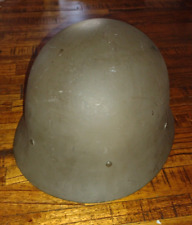
Swedish M26 Steel Metal Military Helmet w/ Leather Liner M1926 NEW ca. 1940 WWii $84.78
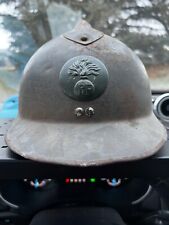
WW2 FRENCH M26 Adrian Helmet WWII Army $180.00
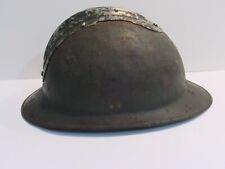
WWII FRENCH ADRIAN HELMET MODEL 1926 M26 / INFANTRY / INFANTERIE $70.00
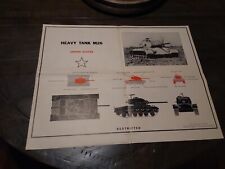
M26 Heavy Tank US Army WWII Tank Silhouette Training Poster 1944 $45.00
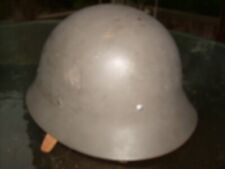
Pre-WWII Swedish M26 Steel Helmet w/ Liner & Chinstrap, Large 69, M1926 Sweden $59.00
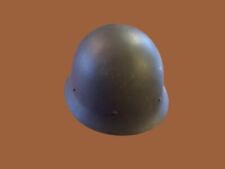
PRE WWII SWEDISH HELMET WITH LINER AND LEATHER CHIN STRAP M-26 SWEDEN MARKED $94.85
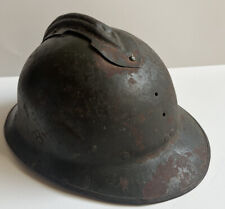
WWII French Army M26 Adrian Helmet Complete Liner WW2 Named Battle Used Original $249.99
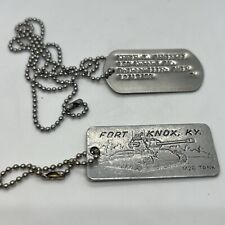
Vintage WWII Period Fort Knox, KY. M26 Tank Engraved & Dog Tag $14.00
|